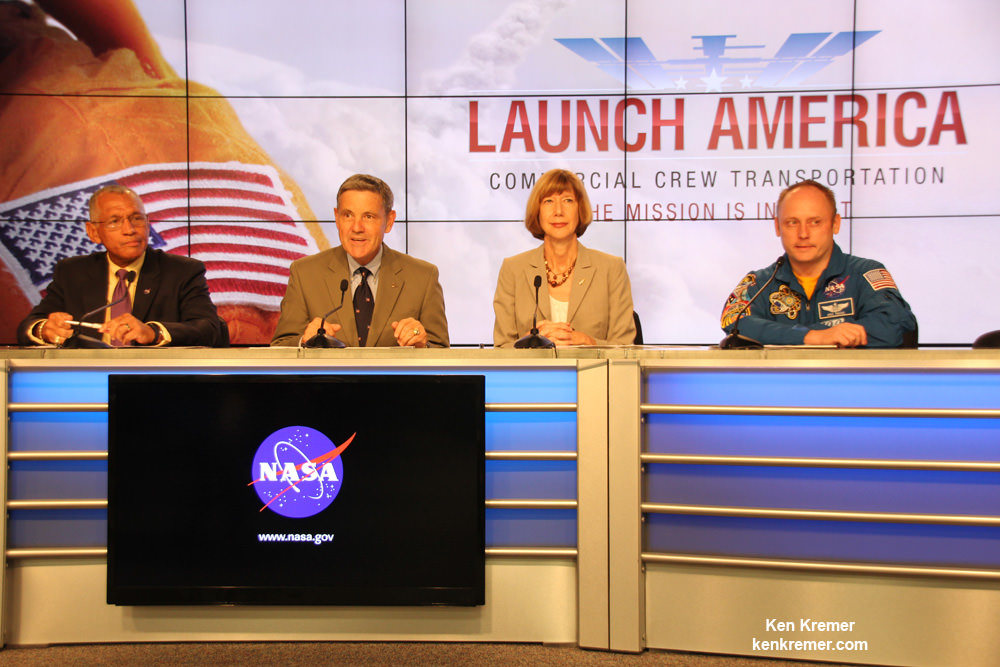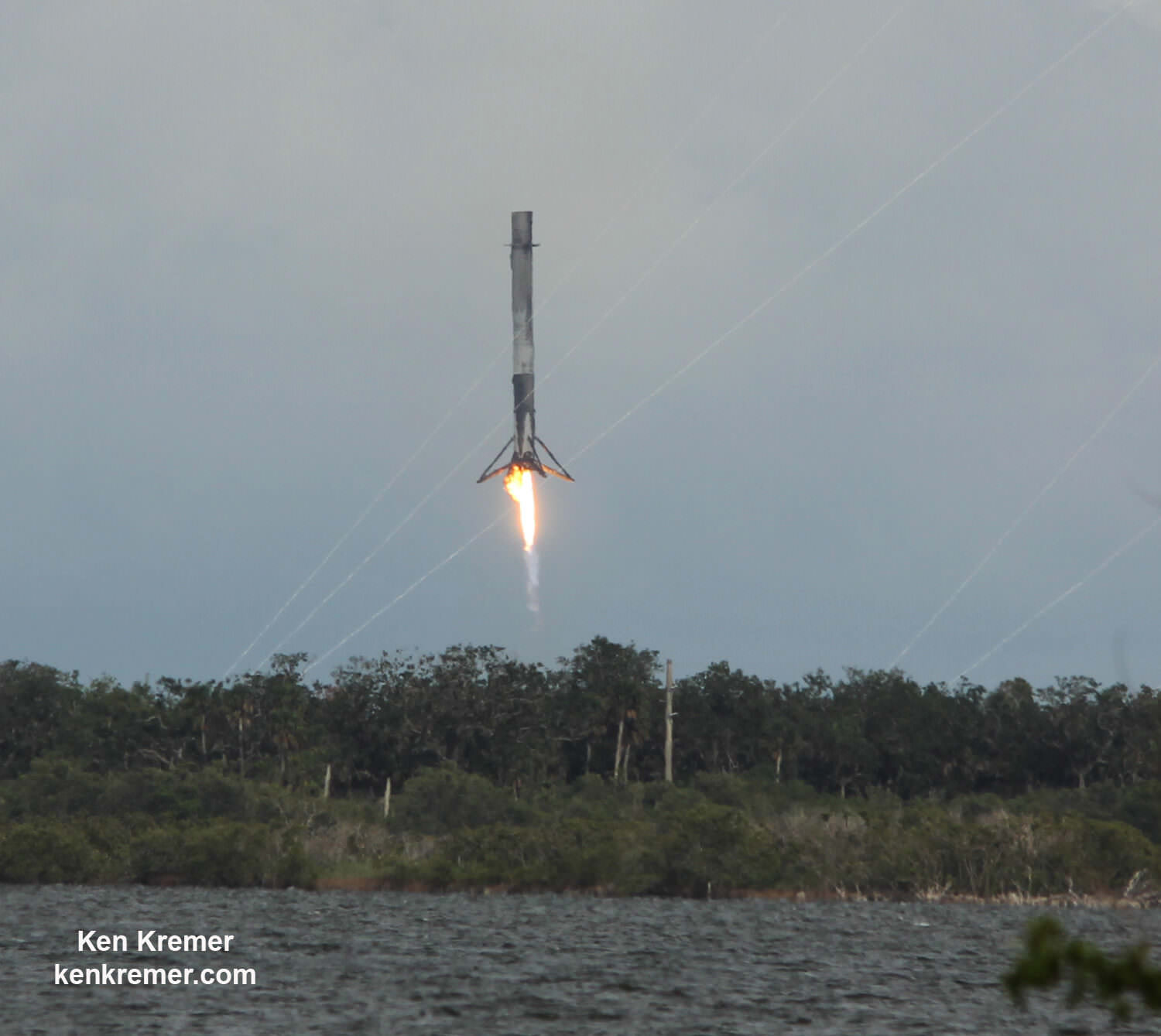
Artists concept for sending SpaceX Red Dragon spacecraft to land propulsively on Mars as early as 2020. Credit: SpaceX
SpaceX is dropping its original plans to propulsively ground land the advanced crewed version of their Dragon spacecraft planned for missions carrying astronauts returning from the International Space Station (ISS) - in a decision that potentially impacts future plans for Mars landings as well.
The announcement came directly from SpaceX CEO and founder Elon Musk while speaking at the International Space Station Research and Development Conference in Washington, D.C. on July 19.
For "safety" reasons, Musk said the SpaceX Crew Dragon will no longer have the ability to use its built in Super Draco thrusters to accomplish a soft landing on land while extending a quartet of landings legs. The SuperDraco thrusters function as the launch abort system to save the astronauts lives in case of a launch emergency.
"It was a tough decision," Musk said when asked about his latest plans at the conference. "Technically it still is. Although you'd have to land it on some pretty soft landing pad because we've deleted the little legs that pop out of the heat shield."
ISS Conference photos herein courtesy of Trevor Mahlmann / http://photos.tmahlmann.com/

SpaceX CEO Elon Musk discusses crew Dragon at the 2017 International Space Station Research and Development Conference in Washington with ISS Program Manager Kirk Shireman. Credit: Trevor Malhmann
SpaceX initially developed the cargo version of the Dragon spacecraft under contract to NASA to conduct resupply missions to the ISS.
In 2014, SpaceX won a follow on $2.6 Billion NASA commercial crew contract to develop and manufacture a significantly upgraded and human rated Dragon vehicle capable of ferrying astronauts to and from low Earth orbit and the space station.
Simultaneously, Boeing also won a $4.2 Billion commercial crew contract to develop the CST-100 Starliner vehicle.

NASA Administrator Charles Bolden (left) announces the winners of NASA's Commercial Crew Program development effort to build America's next human spaceships launching from Florida to the International Space Station. Speaking from Kennedy's Press Site, Bolden announced the contract award to Boeing and SpaceX to complete the design of the CST-100 and Crew Dragon spacecraft. Former astronaut Bob Cabana, center, director of NASA's Kennedy Space Center in Florida, Kathy Lueders, manager of the agency's Commercial Crew Program, and former International Space Station Commander Mike Fincke also took part in the announcement. Credit: Ken Kremer- kenkremer.com
Both Starliner and Dragon can transport four of more astronauts to the ISS and back.
The unpiloted Dragons return to Earth via parachute assisted splashdowns in the Pacific Ocean using a trio of parachutes.
When Musk unveiled the Crew Dragon, SpaceX had designed it also to initially return via ocean splashdowns using four parachutes for the initial missions, but would eventually transition to the propulsive land landings in the not to distant future.
Musk also announced plans to develop another version dubbed 'Red Dragon' to conduct unmanned landings on the Red Planet using supersonic retropropulsion – as soon as 2020.
However Musk has now nixed those propulsive landing efforts for both the Crew and Red Dragon spacecraft for reasons of time and safety.
The inaugural launches of the SpaceX Crew Dragon and Boeing Starliner have both been postponed has been postponed multiple times as the firms work to satisfy NASA's strict certification requirements and deal with funding cutbacks from the US Congress that slowed development.
"The reason we decided not to pursue [propulsive landings] heavily is it would have taken a tremendous amount of effort to qualify that for safety, particularly for crew transport," Musk said.
"There was a time when I thought that the Dragon approach to landing on Mars, where you've got a base heat shield and side-mounted thrusters, would be the right way to land on Mars, but now I'm pretty confident that is not the right way, and that there's a far better approach."
He didn't elaborate the details about the alternate approach.
"That's what the next generation of SpaceX rockets and spacecraft is going to do, so just the difficulty of safely qualifying Dragon for propulsive landings, and the fact, from a technology evolution standpoint, it was no longer in line with what we were confident was the optimal way to land on Mars," Musk said. "That's why we're not pursuing it. It could be something that we bring back later, but it doesn't seem like the right way to apply resources right now."
SpaceX is focusing on the crew Dragon with a maiden launch with astronauts slated for mid-2018.
"It's been way more difficult than cargo, for sure," Musk said. "As soon as people enter the picture, it's really a giant step up in making sure things go right. For sure, the oversight from NASA is much tougher. I thought it was tough for cargo, but it's really intense for crew."
"It can be a bit tough on the men and women at SpaceX, but I know where its coming from," Musk elaborated.
"It's the right motivation, and there will be some debates going into next year about some of the technical details. Is this right or that right? But I think we really want to make everything humanly possible to make sure it goes well, and triple check everything."
Currently, SpaceX recovers the Falcon 9 first stage booster by deployed four landing legs in the final moments of the precision guided propulsive touchdown either on land or on ocean going platforms.

SpaceX Falcon 9 booster deploys quartet of landing legs moments before precision propulsive ground touchdown at Landing Zone 1 on Canaveral Air Force Station barely nine minutes after liftoff from Launch Complex 39A on 3 June 2017 from the Kennedy Space Center in Florida on the Dragon CRS-11 resupply mission to the International Space Station for NASA. Credit: Ken Kremer/Kenkremer.com
To date SpaceX has successfully demonstrated the recovery of thirteen boosters.
Furthermore SpaceX engineers have advanced to the next step and successfully recycled, reflown and relaunched two 'flight-proven first stages this year in March and June of 2017 from the Kennedy Space Center in Florida.
Watch for Ken's onsite space mission reports direct from the Kennedy Space Center and Cape Canaveral Air Force Station, Florida.
Stay tuned here for Ken's continuing Earth and Planetary science and human spaceflight news.
No comments:
Post a Comment